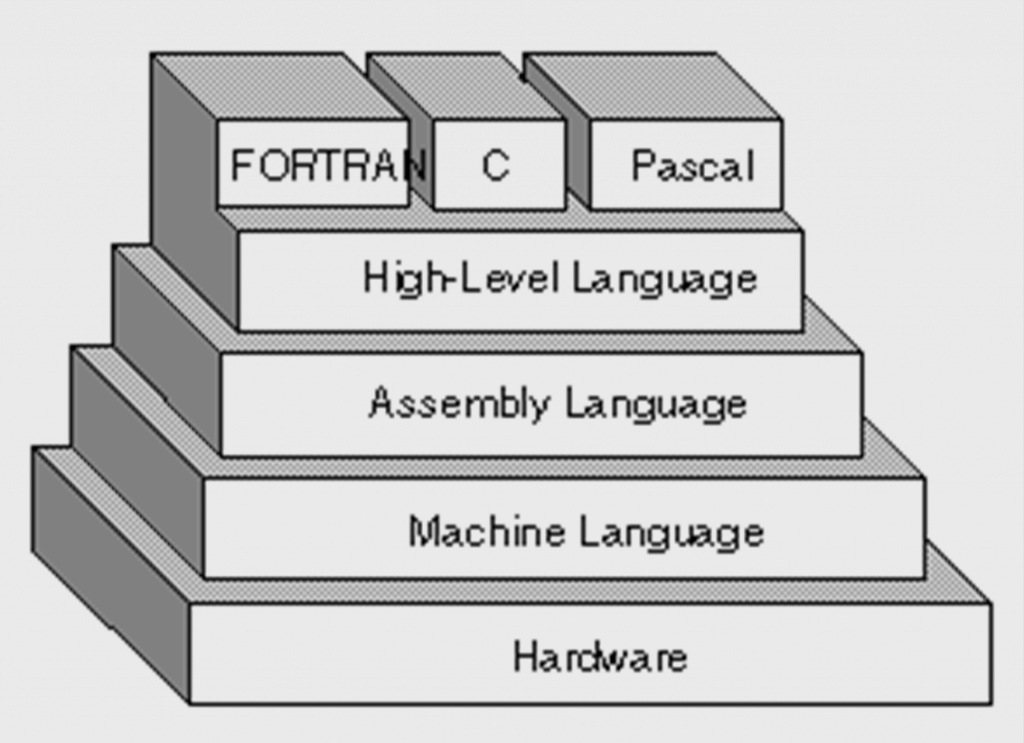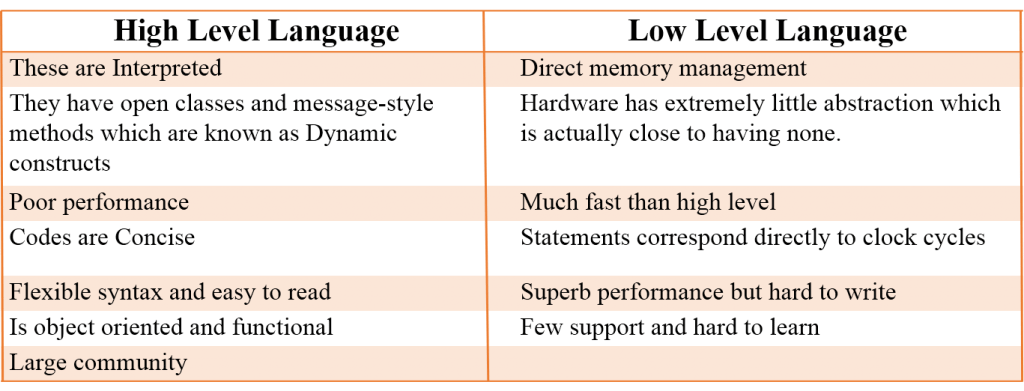Updated April 17, 2023

Difference Between High-level languages vs Low-level languages
This is a beginner-level article explaining the differences between high-level languages and low-level ones. What do these two categories mean, and why are they named such? Furthermore, what are the differences between the two?
High-level vs Low-level Languages: Head-to-Head Comparison (Infographics)
The following are the top differences in a detailed manner.
What are High-Level Languages?
With the help of high-level languages, one can write portable applications across various platforms (such as Linux or Windows). They are independent of any architecture (such as non-intel ARM or the infamous Intel). Examples of high-level languages include Python, which by default works in any Linux system, then compiling it into an exe using py2exe and running it on Windows.
Similar examples are Python, C, Fortran, or Pascal. Such languages are considered high-level languages because they are closer to human languages and much further from machine languages. When I say human language, I don’t mean what we talk about in our day-to-day life. It means the code is something we can understand by knowing some basics of programming. The code written can be read and pronounced by humans.
Following are some examples of machine language to print out a simple program on-screen in Fortran and C.
In Fortran:
program NewProgramF90
write(*,*) "This is a printed program"
end program NewProgramF90
Now you can compile it using:
gfortran newprogram.f90 -o newprogram -f90-gcc
And then just simply run it.
A similar program in C:
#include<stdio.h>
main()
{
printf("This is a printed program");
}
For pure beginners, this is the easiest it can get.
But however, since we are talking about computers, this is hard to understand for a computer. So in order to make this sensible for computers and run a program created with a high-level language, it must be compiled into machine language.
Image Source: github.com
And this is where low-level language comes in between. Unlike previously, where there were only a few high-level languages, today there are n number of high-level languages such as C, Cobol, FORTRAN, Pascal, Java, Perl, Python, PHP, Ruby, C++, BASIC, and Visual Basic.
What are Low-level languages?
Low-level languages are extremely close to machine language. They are also known as Assembly languages. The closest languages after Assembly to Machine language are C and C++. Some people even call C and C++ low-level languages. Machine code is known as low-level because, unlike high-level programming languages, it doesn’t need anything like compilers. It runs directly on the processor, and they are extremely architecture-specific.
Low-level languages are more appropriate for developing new operating systems or writing firmware codes for microcontrollers. They can do anything with a little bit of hard work (actually a lot of hard work, to be specific), but obviously, you won’t want to write some major application. Similar is the case with C, which is actually a very vast language to start with. It allows you to register directly and give instant access to various memory locations.
But at the same time, it also has a lot of constructs that allow the hardware to load abstraction. Frankly speaking, C and C++ dually represent a variety of languages since most languages have taken their libraries from them. In practice, C and C++ are low-level, because writing applications on the enterprise level is quite difficult. But theoretically, both of them are actually high-level languages.
Characteristics
The different characteristics are as follows:
Now, the thing is that every once in a while, I have been asked in various interviews and other places which of them is the best: low-level or high-level programming. It seems to me that there is no such thing as the best. The answer is that they both have their own specialty, and you cannot replace one for the other.
Low-level Programming is challenging and requires a great deal of experience and knowledge. Features of High-level languages is where all the creative things take place, i.e. applications that people use in their day-to-day life, and they can be debugged much easier than in low-level. And here, you can work with extremely new technologies since many languages upgrade continuously due to community support.
If you question any high-level language coders about what they like, the answer you will receive would be far from what you require. They won’t tell you which is better.
They probably will say they are more passionate about a specific high-level language than all. The most famous examples are Python and Ruby, and if you show them some programs in assembly language, you will probably go to hasta-la-vista.
Image Source: mathworks.com
What’s actually superb about many high-level languages is that they fall into the hybrid category. For example, Python is extremely object-oriented, but at the same time, it also supports closures and first-class functions. Though it’s not as powerful as Scala, it can represent more or less stuff as that of a pure language.
High-level languages are usually slow in comparison to low-level languages. This is because high-level languages have a lot of abstractions and layers of code before they reach the hardware itself. In contrast, since machine code is nearer, processing and returning the output is faster. One piece of Python code translates into thousands of lines of machine words.
Of course, high-level languages are at par where raw performance is unnecessary because you cannot develop as stable and large applications at a low-level as at a high-level. This is one thing worth remembering.
What C Programming is used? The Low-level/High-level Confusion
Though C has many characteristics similar to the Pascal Language, sometimes it is still considered a low-level language. It supports operations of bits, pointers, and direct access to memory. C is actually a high-level language with the inclusive features of low level. This is why programmers depend on C over anything for its unbeatable qualities.
Though treated as a low-level language, it may seem weird that C is extremely portable. Fanatically speaking, C is actually extended to use hardware at its extreme limits possible.
Assembly language, on the other hand, is hardly portable. Though, trying to achieve portability is a big deal in the case of low-level, especially in the case of Java, which runs on a JVM, i.e. a virtual machine. C or Assembly running in a VM will never have pure access to the hardware.
To be more precise, a language becomes a low level if it is specifically structured to run directly on the hardware. Low-level languages have very little syntax, unlike high-level languages, which have loads of codes.
Low-level languages, which allow full hardware access, would be a poor choice for writing projects.
When to Use Low-level?
A machine code looks something like this, which runs extremely fast since it is very close to the hardware.
8B542408 83FA0077 06B80000 0000C383
FA027706 B8010000 00C353BB 01000000
B9010000 008D0419 83FA0376 078BD98B
C84AEBF1 5BC3
Above is a function for a 32-bit architecture, i.e., x86 machine code, to calculate the Fibonacci number.
Writing machine code is indisputably quite irritating because it requires checking numerical codes every now and then for every other instruction that runs. No one has the time for that, which is why low-level Programming was born.
But if you ask about low-level programming to high-level programmers, the answer you would get is this:
Image Source: pixabay.com
Conclusion
Low-level languages have the added advantage of losing control of the CPU, but their codes are extremely difficult to understand and debug by fellow programmers. Every other architecture family has its own assembly language set, which means that code written for one is impossible to run on the other. This means the code is not portable.
High-level language advantages are that they are extremely portable; on the other hand, they mostly serve in writing software that can run on multiple platforms and architectures. Neither can replace the other because the two are two sides of the same coin.
Recommended Articles
Here are some further articles to learn more:






